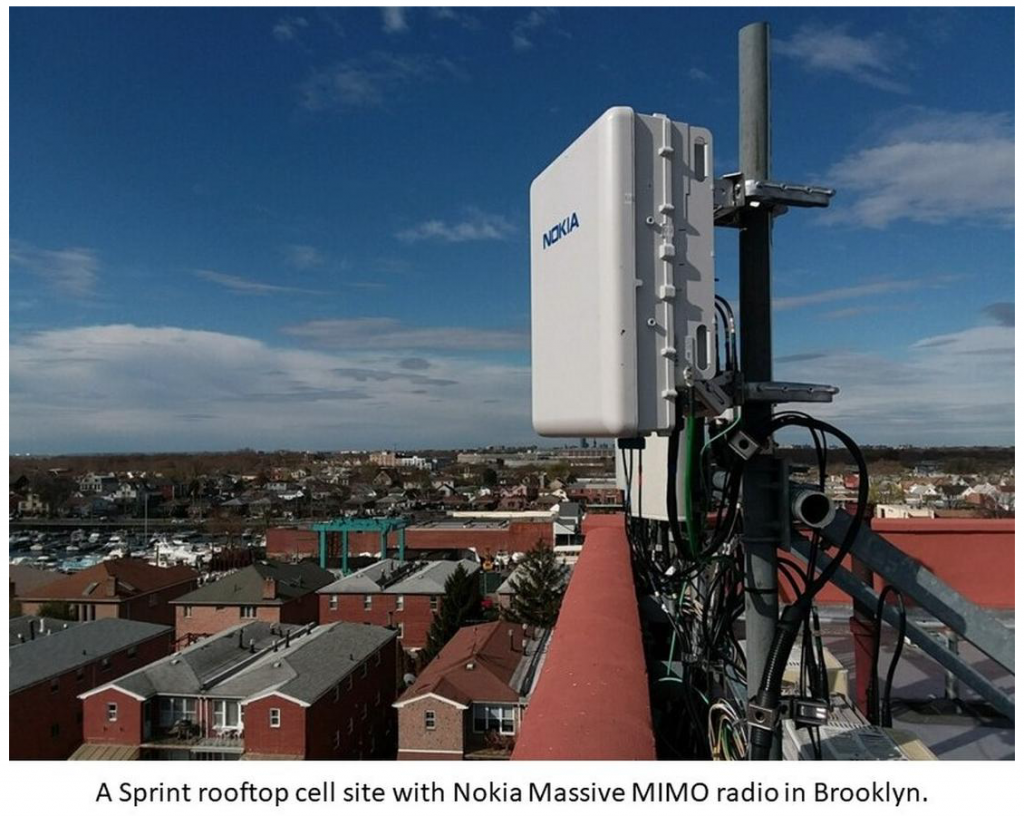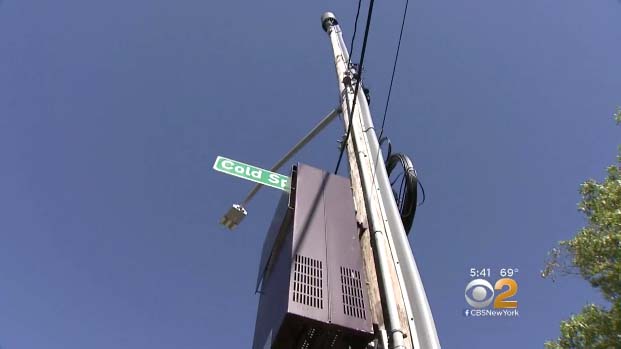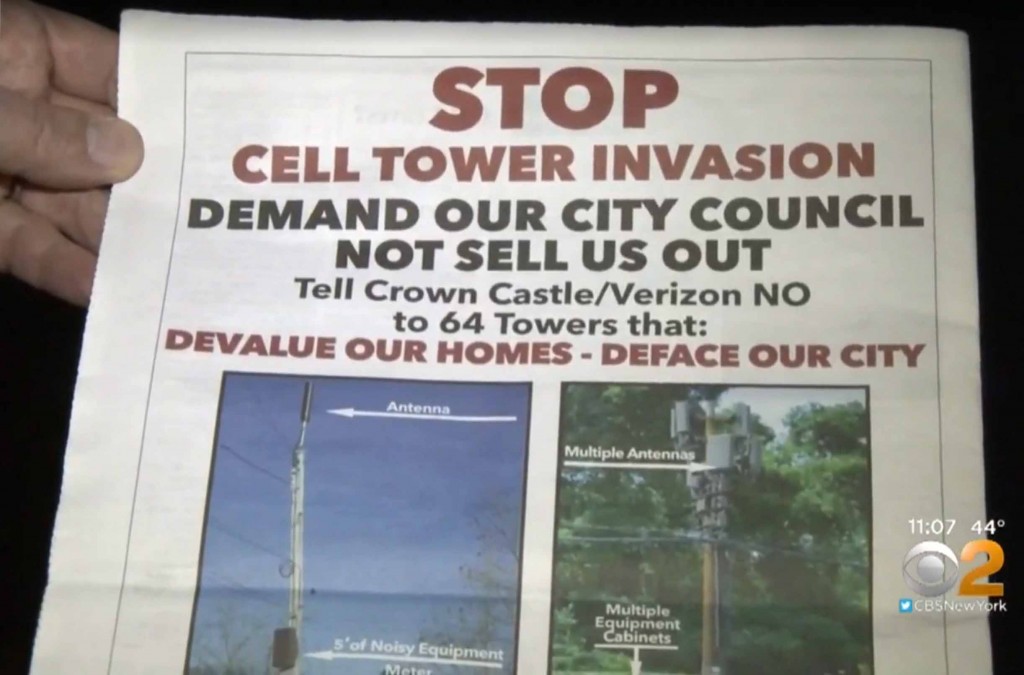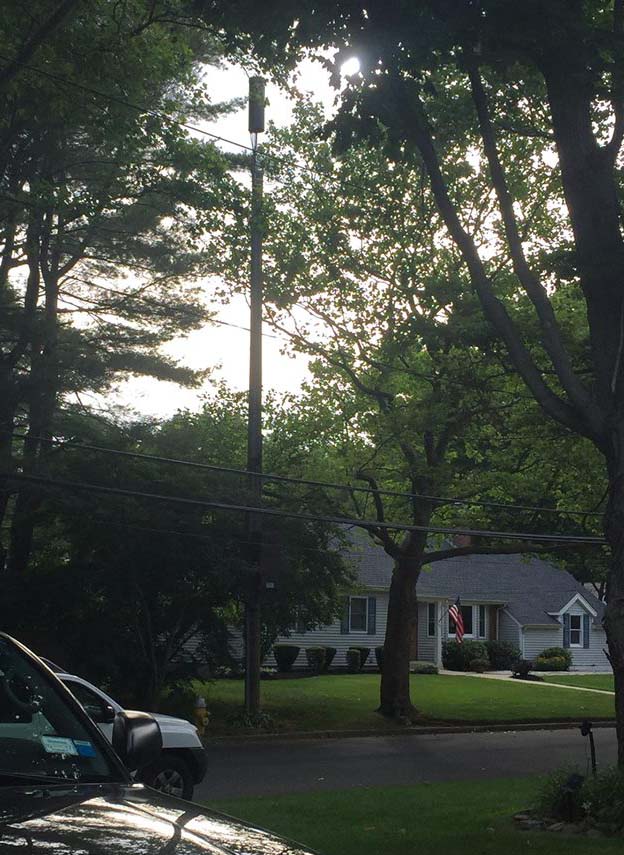https://www.youtube.com/watch?v=zjZMPLyfFc8
Sprint preps New York City for 5G
Sprint is deploying 5G-ready Massive MIMO radios across New York City, as well as attaching thousands of indoor and outdoor small cells to city infrastructure.
By Corinne Reichert | https://www.zdnet.com/article/sprint-preps-new-york-city-for-5g/
Long Islanders Sue Over Health Concerns About New Cellphone Towers
MINEOLA, N.Y. (CBSNewYork) — Long Island residents are raising health concerns as cellphone transmission equipment continues to be installed in many areas.
As CBS2’s Jennifer McLogan reported, some neighbors are joining together to fight towers going up close to their homes, schools and houses of worship.
Jodi and Peter Abraham anxiously clutched their just-filed federal lawsuit as they walked out of Nassau County Supreme Court Thursday, challenging hundreds of unregulated and wireless facilities, still going up by the dozens across Huntington and Oyster Bay.
“We are not anti-tech. We are not anti-cellphone,” Peter Abraham said. “But we believe cell towers should be put up in a responsible way.”
The Abrahams called CBS2 to their home last December, when in an overnight period, they said a pole with a wireless box was installed on the edge of their front property. They confronted the installer – Crown Castle – and the town for an explanation.
“I want a voice,” said Jodi Abraham. “And I want my town to stand up for us – you know, their residents. And they have told us their hands have been tied.”
A Huntington town official explained the stated purpose of the cell towers.
“Crown Castle has told the town that this is designed to fill in gaps in cellphone service in the town,” said Town of Huntington spokesman A.J. Carter.
As they joined hands in front of the courthouse, worried homeownerssaid the law must be changed to stop the new towers from being allowed.
“This is an issue that is critical — not just to all of Long Island, but all of the United States,” said plaintiffs’ attorney Andrew Campanelli, “because across the United States, no wireless facilities are being tested.”
Some call it a microwave brew – steps from their bedroom windows. Are radio frequency emissions mushrooming out to envelop nearby schools and churches?
The Federal Communications Commission has RF thresholds, but the agency says it has not enough resources to test them.
“Who’s monitoring that what the FCC says is a ‘safe limit’ is actually what’s coming out of these things?” said Oyster Bay homeowner Sandra Decker. “We don’t know that.”
Currently, several California communities are requiring wireless installers to pay for independent safety checks.
“We understand that technology is moving forward. I understand that,” said Oyster Bay homeowner Rosalie Menduni. “Let’s do it mindfully.”
Residents now want the FCC to conduct regular radiation readings, and embark on a new study testing health effects of wireless boxes and cell phone towers.
The wireless company named in the lawsuit Thursday, Crown Castle of Texas, did not return CBS2’s calls for comment.
WATCH VIDEO
http://newyork.cbslocal.com/2017/10/19/long-island-cellphone-towers-lawsuit/
Oyster Bay supervisor vows town will limit cellphone antennas
Updated May 11, 2017 8:40 PM
Nassau, Oyster Bay, LONG ISLAND, NY
By David Olson
On Thursday, May 11, 2017, Oyster Bay Supervisor Joseph Saladino, speaking to a group of Woodbury residents who had just held a news conference to express frustration over cellphone repeaters installed in their neighborhood, said the town is drafting a new ordinance to limit the installation of cellphone repeaters and is exploring legal ways to get about two dozen repeaters removed from residents’ properties. (Credit: Newsday / Chuck Fadely)
Oyster Bay Supervisor Joseph Saladino on Thursday said the town is drafting a new ordinance to limit the installation of cellphone antennas and is exploring legal ways to get about two dozen of them removed from residents’ properties.
“We will make sure our voice is heard as we stand in lockstep with our residents to protect their rights and protect our communities,” Saladino said.
Saladino spoke on the street in front of a 30-foot-high antenna that was recently installed on the public right of way of Woodbury resident Denise Tufano’s front lawn. Tufano and others had held a news conference on the site to complain about the aesthetic, property-value and possible health effects of the antennas and urge the town to take action.
The antennas, part of the Verizon Wireless network, are called “small cells” and are installed closer to users to improve coverage, the company said in a statement.
Saladino found out about the news conference and, several minutes after it ended, arrived with other town officials to talk to reporters and residents.
One of the speakers and organizers of the news conference was Democratic supervisor candidate Dr. Marc Herman. Saladino, a Republican, and Herman accused each other of playing politics with the issue.
Herman said he was acting not as a candidate but as president of the Gates Ridge Civic Association in Woodbury. He asked why action hadn’t been taken earlier and why notice wasn’t given to residents of their installation.
Saladino, who took office Jan. 31, said he and town officials have been looking into residents’ complaints about the antennas for weeks. He announced at Tuesday’s board meeting that the town had rescinded seven permits for antennas.
Saladino said Thursday that the antennas should not be placed in residential neighborhoods and he urged the Federal Communications Commission to conduct radio-frequency testing near the devices, turn off any that are currently functioning, and study the health effects of antennas.
Deputy Town Attorney Matthew Rozea said a federal law limits municipal restrictions on cell phone equipment. Saladino called on Congress to change the law “to give local municipalities the right to determine where these go.”
Vicki Kramer, who has an antenna next to her Woodbury driveway, said she is worried about her two teenagers and other neighborhood kids, especially with the long-term health risks of the antennas not known.
Long Island, NY : Westchester Residents Concerned About Plans For New Cellphone Poles
December 7, 2016 11:11 PM
Filed Under: Cellphone Towers, Crown Castle Presentation, Huntington, Jennifer McLogan, Long Island, Lou Young, Rye, Suffolk County
RYE, N.Y. (CBSNewYork) — Towering poles topped with cellphone booster equipment are now lining the streets of some Westchester County and Long Island neighborhoods – and some are calling them an eyesore.
But as CBS2’s Lou Young reported, even more of the poles are expected to be installed.
The new cellphone equipment is invading Rye. Some towers already have been attached onto and above existing utility poles, and dozens in total are proposed in Rye alone.
Opponents fear it is just the start. “The 64 coming in would be Verizon nodes, but other carriers and infrastructure builders can come in and do exactly the same thing,” said Joshua Cohn of Rye. The mayor said the fact is that upgrades for cellphone networks are necessary.
“We all have (cellphones). We all use them,” said Rye Mayor Joe Sack. “And as a result, the wireless providers have to upgrade their network.” But while there are only 10 of the new units in Rye now, the sudden expansion proposal has stiffened opposition. Neighbors say they are not only big, but in the summer, internal cooling fans make them noisy as well.
“Walking the dog, I can hear it. It’s like a low whirring sound,” said Madeline Peron of Rye. Other communities are already reacting to the arrival of cellphone equipment. In Huntington, Long Island, 166 poles were recently approved and went up – much to the shock of those living nearby.
Jodi Abraham awoke this week to a new pole with a booster box and converters pointed right at her Huntington home. “This is new technology, we’re not sure, like most people we don’t know the health effects of it,” she told CBS2’s Jennifer McLogan. Her husband Peter wants nothing to do with the new installations. “I don’t want it on my property,” he said. “And I don’t want it adjacent to my property and my children.” The Abrahams and their neighbors claim no one with Town of Huntington alerted the community that it was entering an agreement with a giant telecommunications company. Peter demands to know how permits were passed and why residents weren’t previously told about it. A public hearing called Crown Castle Presentation was held in July. As CBS2’s McLogan reported, few in the community knew it was a company seeking to rent space on the poles to multiple cellphone providers.
The township claims they have limited authority, and the antennas pass government health and safety testing. Huntington town spokesman A.J. Carter tells CBS2 that Crown Castle told the town that the equipment is designed to fill in gaps in cell phone service. He claims the initiative is not a money making venture for the town.
CBS2 reports that Huntington stands to make about $230,000 in permit fees, along with 5 percent of future monthly gross revenue for 10 years for equipment placed in right-of-ways. “It feels like the town can do whatever it wants,” said Jodi.
Back in Rye, opponents are petitioning their city council to keep the cell equipment on public property and out of residential neighbourhoods. Mayor Sack insists the equipment is safe despite the lack of aesthetic appeal. “Telephone poles are not pretty objects, OK?” he said. “And when you put one of these antennas on top of one, they kind of blend in, you know, with the preexisting ugliness.”
Texas-based Crown Castle is trying to secure the utility pole leases for Westchester and Long Island, as well as for New York City. Multiple calls to the telecom company have not been returned.
WATCH VIDEO :
http://newyork.cbslocal.com/2016/12/07/cbs2-exclusive-li-residents-concerned-about-cell-phone-poles/
NewYork – CBSNewYork.com
Cell Phone Poles In Westchester County Causing Concerns
••••••••••••••••••••••••••••••••••••••••••••••••••••••••••••••••••••••••••••••••••••••••••••••••••••••••••••••••••••••••••••••••••••••
Cellphone Antennas to Sprout Atop Light Poles and Signs
By IAN URBINA NY TIMES – JULY 30, 2004
At more than $6,000 a month for a few square feet, it may be the most expensive real estate in New York.
The thin sliver of space on top of lampposts, traffic signals and highway signs is where the city plans to allow telecommunications companies to put cellphone antennas and Internet transmitters.
The plan, which will add about $21.3 million to city coffers, will improve spotty cellphone reception — and turn many intersections into wireless Internet ”hot spots.” But, city officials say, it will also help those who cannot afford regular telephone service, by providing a cheaper option, through wireless Internet-based access, in neighborhoods with the fewest connections to the phone network.
Opponents of the plan say that the only thing the antennas will bring is an increased health risk. ”We have no idea what dangers are posed by the concentration of these devices,” said Councilman Peter F. Vallone Jr. of Queens, explaining that the city does not keep records of the numbers or locations of the antennas already in the city. ”They keep saying that these things are less dangerous than microwave ovens,” Mr. Vallone said, ”but no one has a microwave running 24/7, right next to their bedroom window.”
City officials say the plan is needed to keep pace with the rapidly growing use of cellphones and wireless Internet connections. The antennas and Internet relay boxes will start appearing on city poles before the end of the summer, said Gino P. Menchini, the city’s commissioner of information technology and telecommunications. About 18,000 spots will be leased.
The pole-mounted antennas will allow the city to shift away from the larger cellular base stations that emit higher radiation and are located on many rooftops, Mr. Menchini explained. And since one of the franchise companies will install universal antennas, which can be used by all cellphone providers, the new setup will actually lower the overall number of antennas needed.
”We see this as a win-win situation,” Mr. Menchini said.
Evie Hantzopoulos of the Astoria Neighborhood Coalition, which opposes the unchecked spread of antennas in the city, sees it otherwise.
‘There has been a complete lack of public input on this and the city has given the telecommunications industry carte blanche access,” Ms. Hantzopoulos said. ”It’s not just dangerous, it’s irresponsible.”
While there has been widespread concern about radiation from cellphone towers posing a risk of cancer and infertility, most scientific studies have not found a link.
The six companies granted access to the poles include two cellular providers, Nextel and T-Mobile, and three non-cellular companies, ClearLinx Network Corp., Crown Castle Solutions and Dianet Communications. The sixth company, IDT Business Services, will offer telephone service via the Internet. Each company will be allowed to use a maximum of 3,000 poles citywide for a term of 15 years.
The current plan offers access to poles in three separate zones for different prices. Zone A includes Manhattan south of 96th Street. Zone B is everywhere in the city not included in the other two zones. Zone C consists of a patchwork of neighborhoods in Brooklyn, Manhattan and the Bronx where five percent or more of the houses do not have telephone service.
Agostino Cangemi, deputy commissioner of information technology and telecommunications, said a big advantage of the franchise plan is that it will provide phone access via the Internet in Zone C, areas typically home to lower-income and immigrant families that rely on public pay phones and high-priced phone cards.
IDT Business Services, a company based in Newark, will provide customers in Zone C Internet phone devices and accounts to which they can add pre-paid minutes, Mr. Cangemi said. The Internet phones will cost less than most cellphones, and there will be no credit checks, he said.
•••••••••••••••••••••••••••••••••••••••••••••••••••••••••••••••••••••••••••••••••••••••••••••••••••••••••••••••••••••••••••••••••••••••••••••••••••
March 2018
The New York State Conference of Mayors and Municipal Officials opposes a bill in the legislature to usurp municipalities’ power to regulate cell antennas.
If you live in New York State you can contact your municipality (city) and say you oppose this bill too.
New York Cities Object to Proposed State Rules on 5G Towers
The state of New York is looking to regulate what towns will be able to charge for the newest cell transmitters.
BY RICK KARLIN, TIMES UNION / MARCH 20, 2018
(TNS) — ALBANY — A regulation tucked into Gov. Andrew Cuomo’s budget plan regarding cell towers is pitting local governments against the state and major telecom providers like AT&T and Verizon.
The proposal would set statewide standards for approving and charging for the use of cell towers, telephone poles or other fixtures that wireless providers use to carry their signals via the newly emerging 5G technology.
Municipal officials say that impinges on their local control of cell towers.
“This legislation would handcuff the ability of every municipality in New York state to manage access to their public rights-of-way,” states a memo on the proposal from the state Conference of Mayors.
State officials, though, say local governments would still deal with cell tower applicants. “The bill sets up a uniform process entirely administered by local governments, allowing for local control while encouraging private investment to expand service,” said Budget Division spokesman Morris Peters.
Much of the fight appears to center on money and a clause that would impose a $200 annual rental limit for each small cell signaling device a carrier put on a pole.
“Significantly, this bill seeks to limit how much a municipality may charge a wireless provider when renting space on municipally-owned structures,” reads the memo.
Some municipalities including Buffalo have wanted to charge up to $2,000 annually for each device.
The catch is, with the developing 5G technology, wireless transmitters need to be placed as close as 500 feet apart. That means a town could have dozens or even hundreds of devices.
Paying thousands of dollars per year, per device would make it uneconomical, say those in the telecom industry.
“Who is going to deploy with those costs?” asked Robert Puckett, president of the state Telecommunications Association.
Also known as “small cell,” 5G is viewed as the next generation of wireless technology which has so much capacity that it could eventually replace the need for hard-wired services.
Rather than hooking into a copper or even fiber-optic wire, 5G proponents say consumers will eventually be able to get all their web-based services via these densely-packed wireless signals.
Proponents note that 5G technology will help bring high-speed broadband service to upstate areas that currently don’t have it.
“It’s really an economic development issue,” said Marissa Shorenstein, Northeast President for AT&T which like Verizon is anxious to move forward with the technology.
She noted that some other states have already moved ahead with the kind of uniform regulations and price limits that they want in New York.
“We’re going to deploy small cells to places where we’re wanted,” she said.
Municipalities aren’t the only ones upset with the proposal. Representatives of the cable industry, which relies on hard wiring, say the plan creates an unlevel playing field.
That’s because cable firms still have to negotiate their rights of way with local municipalities, said Lara Pritchard of Spectrum cable.
She as well as the Cable Telecommunications Association believe the proposal should also be discussed outside of budget talks, which are supposed to be finalized in less than two weeks.
Existing cell tower transmitters have generated a lot of cash for municipalities around the state.
In the town of Bethlehem, for example, cell carriers pay about $2,400 per month to rent, or use the right of way on structures like a town water tower, said Paul Penman, the town’s deputy commissioner of public works.
But rather than having a handful, the 5G system would require scores of transmitters.
Some industry observers believe the gap between the $200 cap and, say, the $2,000 fee sought in Buffalo, will serve as a starting point for bargaining that will likely take place between now and the final state budget.
http://www.govtech.com/network/New-York-Cities-Object-to-Proposed-State-Rules-on-5G-Towers.html
RELATED
FCC Ruling on 5G Infrastructure May Hurt CitiesLeaders in Brunswick, Md., Adopt New Small Cell RegulationsGaston County, N.C., OKs Disputed Cell Installation
5G Equipment Quietly Being Installed On Rhode Island Street Lamps
5G is coming, whether any of us want it or not. At least that’s the approach some states and wireless companies seem to be taking when it comes to the controversial fifth-generation wireless network. Wires and boxes now clutter Providence light poles and traffic lights, however, people in the area have no idea how they got there. Worse more, state agencies and major telecommunication providers refuse to respond to media inquisitions. Yes, 5G is quietly being installed in some of our cities with no accountability.
City officials announced the first phase of 5G cell network roll-out last week. The new network aims to increase Internet speeds. However, 5G health risks have many citizens concerned.
But people seeing the new installs are at a loss for how they got there. This is because media request to Verizon, the governor’s office, and Rhode Island Department of Transportation have gone ignored. This leads many to believe the state is installing 5G without any accountability. State officials seem to refuse to communicate or debate the matter in a public forum. Instead, they will continue to establish the networks all over the region.
Gov. Gina Raimondo is a long-time promoter of 5G. Back in 2016, she made clear her position to “make Rhode Island one of the most desirable places to live, work and do business” via 5G network installations. Today, with 5G network installs occurring all over the city, its obvious she’s intent on achieving her goal. She also promoted legislation that sought to stop any regulations that could slow down the mass installations.
“Since the beginning, cities have given utility companies a piece of the public right-of-way. This was necessary to extend electrical, gas and other services to the intended users. In the past, the most obvious result of this was the electric poles and wires that march down city streets or alleyways,” said Brent Runyon of the Providence Preservation Society.
“As we’ve seen with electrical transformers, utility companies are coming up with new things to put onto the right-of-way and there’s been no discussion with the public about how this would affect the character of our communities,” said Runyon. “It is reasonable to expect them to work with the City when they are considering placing a transformer in front of some buildings, though perhaps not all. An example is the one they put underground at the Old State House on Benefit Street.”
Samsung, who is partnered with Verizon on 5G equipment manufacturing, called it’s recent 5G installs in Rhode Island a “5G milestone.”
Rhode Island residents have flooded social media with criticism over the recent installs.
https://prepforthat.com/5g-equipment-quietly-being-installed-on-rhode-island-street-lamps/?fbclid=IwAR1R2TUrEZjpKJd5FoYkWF6TkgcXaICiSPmrl_ZRiukqQFWCT72eytiQvOU
•••••••••••••••••••••••••••••••••••••••••••••••••••••••••••••••••••••••••••••••••••••••••••••••••••••••••••••••••••••••••••••••••••••••••••••••••••
Brooklyn5Gsummit.com
wireless.engineering.nyu.edu
Base Station Diversity Propagation Measurements at 73 GHz Millimeter-Wave for 5G Coordinated Multipoint (CoMP) Analysis
Abstract:
https://ieeexplore.ieee.org/document/8269045/
••••••••••••••••••••••••••••••••••••••••••••••••••••••••••••••••••••••••••••••••••••••••••••••••••••••••••••••••••••••••••••••••••••••••••••••••••••••••••••••••••••
4G/5G Small Cell Antennas – United States
California • Florida • Kentucky • Maryland • Michigan • Minnesota • Missouri • North Carolina • New Mexico • New York •
Ohio • New Jersey • Louisiana • Texas • Rhode Island • Iowa
#BILLS #SB649 #SB331 #S19 #Bill C-648 #S3157




